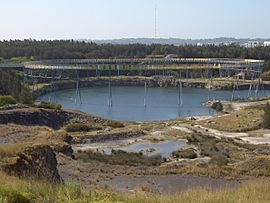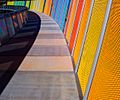Brickpit Ring Walk facts for kids
Quick facts for kids Brickpit Ring Walk |
|
|---|---|

Homebush Bay Brickpit,
with the elevated Brickpit Ring Walk |
|
| Lua error in Module:Location_map at line 420: attempt to index field 'wikibase' (a nil value). | |
| Type | Urban nature park and walkway |
| Location | Bicentennial Park, Sydney Olympic Park, Sydney, New South Wales, Australia |
| Elevation | 18.5 metres (61 ft) above the brickpit floor |
| Designer | Durbach Block Architects |
| Owned by | Sydney Olympic Park Authority |
| Awards |
|
| Paths | 550-metre (1,804 ft) elevated walkway |
| Species | Green and Golden Bell Frog (Litoria aurea) |
| Parking | off Marjorie Jackson Parkway |
| Connecting transport |
In development:
|
| Website | at SOPA |
The Brickpit Ring Walk is a special park and walkway in Sydney Olympic Park, Australia. It's a place where nature and city life mix. This area used to be a big hole where clay was dug out to make bricks. Now, it holds water and is a home for a special type of frog.
The land was going to be used for the Sydney 2000 Olympic and Paralympic Games. But in 1992, something amazing happened. People found the Green and Golden Bell Frog living there. This frog was (and still is) an endangered species. Because of the frogs, plans for building were stopped. The Brickpit Ring Walk was opened in 2006. It lets people see the frogs and the area without disturbing them.
Contents
History of the Brickpit
The land where the Brickpit Ring Walk is located has a long history. It is the traditional land of the Wann-gal people, an Aboriginal clan. Evidence like stone tools has been found nearby. Aboriginal people also had campsites along Homebush Bay and the Parramatta River. These sites, called shell middens, were places where they ate shellfish and other foods. Sadly, many of these were destroyed over time.
The State Brickworks
In 1911, the government of New South Wales decided to open its own brick factory. This was because private companies had too much control over brick prices. The government took over about 9.5 hectares (23.5 acres) of land for the State Brickworks.
It was hard to build the first brick kiln because private companies wouldn't sell bricks to the government. In the early days, bricks were sent by boat to a depot in Blackwattle Bay. From there, they were loaded onto trucks. The State Brickworks started making bricks on November 1, 1911. All the bricks made at first were used for government buildings.
During the 1930s, when there was a big economic problem, the brickworks lost a lot of money. It was sold to a private company in 1936 and closed in 1940. A train station was even built for the workers in 1939.
After World War II, there was a big shortage of bricks. So, the government started the State Brickworks again in 1946. They dug two large pits to get clay for the bricks. Bricks were even sent to other parts of New South Wales. The State Brickworks became very important, making 7% of all bricks in the state. One of the pits was filled in during the 1960s. In 1988, the government decided to close the Homebush brickworks for good.
Popular Culture
From the 1960s to the 1980s, the Brickworks area was known as "Brickies." It was a popular spot for drag racing on Friday or Saturday nights. Drivers would start from a burger place on Parramatta Road and race towards Brickies Hill. You can even see this racing circuit in the 1977 movie The FJ Holden. The Brickworks was also used as a filming location for some scenes in the movie Mad Max Beyond Thunderdome.
The Brickpit Ring Walk
After the brick-making stopped, the large pit filled with water and became a freshwater wetland. In 1992, about 300 Green and Golden Bell Frogs were found living in this wetland. At the time, these frogs were considered endangered.
The area was originally planned to become a tennis center for the Sydney Olympics. But finding these rare frogs stopped those plans. The remaining brick pit is now a protected home for the Green and Golden Bell Frog.
Above the brickpit is the Brickpit Ring Walk. This is a 550-meter (1,800 ft) long walkway that is raised 18.5 meters (60 ft) above the pit floor. It's also an outdoor exhibition space. The walkway lets visitors look down into the nature park and see the frog habitat. This way, people can enjoy the view without disturbing the frogs.
The walkway was designed by Durbach Block Architects in 2005. It has won several awards, including:
- The National Trust Heritage Award in 2006.
- The RAIA (NSW) Lloyd Rees Civic Design Award in 2006.
- The ASI Architectural & Engineering Innovation Steel Design Award (NSW).
- It was even featured at the Venice Biennale in 2006, which is a very important art and architecture event.
Gallery





